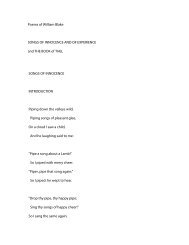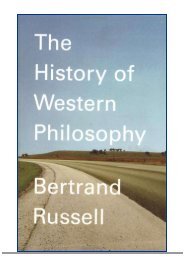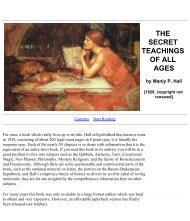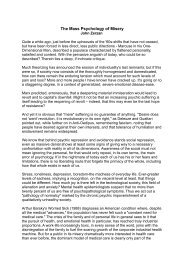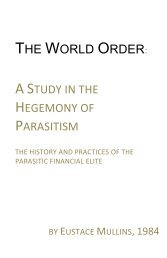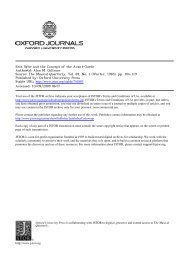2. <strong>The</strong> Perspectival WorldAlthough already shaped in the Mediterranean world of late antiquity, theperspectival world began to find expression about 1250 A.D. in ChristianEurope. In contrast to the impersonal, pre-human, hieratic, andstandardized sense of the human Body — in our sense virtually nonexistent— held by the Egyptians, the Greek sensitivity to the body hadalready evidenced a certain individuation of man. But only toward theclose of the Middle Ages did man gradually become aware of his body as asupport for his ego. And, having gained this awareness, he is henceforthnot just a human being reflected in an idealized bust or miniature of anemperor, a philosopher, or a poet, but a specific individual such as thosewho gaze at us from a portrait by Jan van Eyck.<strong>The</strong> conception of man as subject is based an a conception of the worldand the environment as an object. It is in the paintings of Giotto that weSee first expressed, however tentatively, the objectified, external world.Early Sienese art, particularly miniature painting, reveals a yet spaceless,self-contained, and depthless world significant for its symbolic content andnot for what we would today call its realism. <strong>The</strong>se "pictures" of anunperspectival era are, as it were, painted at night when objects arewithout shadow and depth. Here darkness has swallowed space to theextent that only the immaterial, psychic component could be expressed.But in the work of Giotto, the latent space hitherto dormant in the night ofcollective man's unconscious is visualized; the first renderings of spacebegin to appear in painting signalling an incipient perspectivity. A newpsychic awareness of space, objectified or externalized from the psycheout into the world, begins — a consciousness of space whose element ofdepth becomes visible in perspective.This psychic inner-space breaks forth at the very moment that theTroubadours are writing the first lyric "I"-Poems, the first personal poetrythat suddenly opens an abyss between man, as poet, and the world ornature (1250 A.D.). Concurrently at the University of Paris, ThomasAquinas, following the thought of his teacher Albertus Magnus, asserts thevalidity of Aristotle, thereby initiating the rational displacement of thepredominantly psychic-bound Platonic world. And this occurred in thewake of PetrusHispanus (PetrusLucitanus), the later Pope John XXI (d.1277), who had authored the first comprehensive European textbook onpsychology (De anima), introducing via Islam and Spain the Aristoteliantheory of the soul. Shortly thereafter, Duns Scotus (d. 1308) freedtheology from the hieratic rigors of scholasticism by teaching the primacyof volition and emotion. And the blindness of antiquity to time inherent inits unperspectival, psychically-stressed world (which amounted to a virtualtimelessness) gave way to the visualization of and openness to time with aquantifiable, spatial character. This was exemplified by the erection of thefirst public clock in the courtyard of WestministerPalace in 1283,an event12
anticipated by Pope Sabinus, who in 604ordered the ringing of bells toannounce the passing of the hours.We shall examine the question of time in detail later in our discussion;here we wish to point out that there is a forgotten but essentialinterconnection between time and the psyche. <strong>The</strong> closed horizons ofantiquity's celestial cave-like vault express a soul not yet awakened tospatial time-consciousness and temporal quantification. <strong>The</strong> "heaven ofthe heart" mentioned by Origen was likewise a self-contained innerheaven first exteriorized into the heavenly landscapes of the frescoes bythe brothersAmbrogio and PietroLorenzetti in the church of St. Francescoin Assisi (ca. 1327-28). One should note that these early renderings oflandscape and sky, which include a realistic rather than symbolic astralmythicalmoon, are not merely accidental pictures with nocturnal themes.In contrast to the earlier vaulted sky, the heaven of these frescoes is nolonger an enclosure; it is now rendered from the vantage point of the artistand expresses the incipient perspectivity of a confrontation with space,rather than an unperspectival immersion or inherence in it. Man ishenceforth not just in the world but begins to possess it; no longerpossessed by heaven, he becomes a conscious possessor — if not of theheavens, at least of the earth. This shift is, of course, a gain as well as aloss.<strong>The</strong>re is a document extant that unforgettably mirrors this gain and loss,this surrender and beginning; in a few sentences it depicts the struggle ofa man caught between two worlds. We refer to the remarkable letter ofthe thirty-two year old Petrarch to Francesco DionigidiBorgo San Sepolcroin 1336(the first letter of his Familiari, vol. 4),in which he describes hisascent of MountVentoux. For his time, his description is an epochal eventand signifies no less than the discovery of landscape: the first dawning ofan awareness of space that resulted in a fundamental alteration ofEuropean man's attitude in and toward the world.MountVentoux is located to the northeast of Avignon, where the Rhôneseparates the French Alps from the Cevennes and the principal mountainrange of Central France. <strong>The</strong> mountain is distinguished by clear andserene contours; viewed from Avignon to the south, its ridge slowly andseamlessly ascends against the clear Provençal sky, its south westernslope sweeping broadly with soft restraint toward the valley. After adownhill sweep of nearly two kilometers, it comes to rest against thesycamore slopes of the Carpentras, which shelter the almond trees fromthe northern winds.Although then unaware of its full significance, the present writer saw themountain years ago and sensed its attraction. Certainly this attractionmust have been sensed by others as well; it is no accident that Petrarch'sdiscovery of landscape occurred precisely in this region of France. Here,the Gnostic tradition had encouraged investigation of the world and placedgreater emphasis on knowledge than on belief; here, the tradition of theTroubadours, the Cathari, and the Albigensi remained alive. This is not to13
- Page 5 and 6: deficient forms which have become a
- Page 7 and 8: they could not reach their intent w
- Page 9 and 10: identity, or with his being equated
- Page 11: was especially influential on Greek
- Page 16 and 17: discovery of Augustine's words. "I
- Page 18 and 19: concretion of space, our epoch is c
- Page 20 and 21: While plumbing the hidden depths of
- Page 22 and 23: With Leonardo the perspectival mean
- Page 24 and 25: perspective, had become common prop
- Page 26 and 27: not an avenue. Although man's horiz
- Page 28 and 29: order to obtain a sequential view o
- Page 30 and 31: the truly unrepresentable become ev
- Page 32 and 33: apparent in the development of aper
- Page 34 and 35: characteristics of the structures,
- Page 36 and 37: Structureaugmentation, a loss or a
- Page 38 and 39: "silenced music" of which St. John
- Page 40 and 41: meantime the integral perception an
- Page 42 and 43: homogeneity of the viscera, as well
- Page 44 and 45: Archaic — OriginaryMagicempathy a
- Page 46 and 47: IntegralCreed)Method(Divinity)(Eteo
- Page 48 and 49: that structure itself. Orestes' act
- Page 50 and 51: in its silent meaning, for he dedic
- Page 52 and 53: directed way, and to a mythical dem
- Page 54 and 55: Even though we may be unable to do
- Page 56 and 57: of arational possibilities which ar
- Page 58 and 59: chapters 5, 6, and 7, we would like
- Page 60 and 61: presupposes in any event the mental
- Page 62 and 63:
capability is being formed in him w
- Page 64 and 65:
At the moment when consciousness be
- Page 66 and 67:
temporal aspects enumerated. We are
- Page 68 and 69:
understanding the phenomenon of tim
- Page 70 and 71:
temporal forms which co-constitute
- Page 72 and 73:
crystallizing in a new perception o
- Page 74 and 75:
dream-like and somnolent aspects an
- Page 76 and 77:
ealization now manifesting itself a



